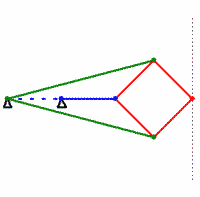
Straight line mechanism
Encyclopedia

Planer (metalworking)
A planer is a type of metalworking machine tool that uses linear relative motion between the workpiece and a single-point cutting tool to machine a linear toolpath. Its cut is analogous to that of a lathe, except that it is linear instead of helical...
and the milling machine
Milling machine
A milling machine is a machine tool used to machine solid materials. Milling machines are often classed in two basic forms, horizontal and vertical, which refers to the orientation of the main spindle. Both types range in size from small, bench-mounted devices to room-sized machines...
, it was extremely difficult to machine straight, flat surfaces. For this reason, good prismatic pairs
Prismatic joint
A prismatic joint provides a linear sliding movement between two bodies, and is often called a slider, as in the slider-crank linkage. A prismatic joint is formed with a polygonal cross-section to resist rotation...
without backlash were not easy to make. During that era, much thought was given to the problem of attaining a straight-line motion as a part of the coupler curve of a linkage
Linkage (mechanical)
A mechanical linkage is an assembly of bodies connected together to manage forces and movement. The movement of a body, or link, is studied using geometry so the link is considered to be rigid. The connections between links are modeled as providing ideal movement, pure rotation or sliding for...
having only revolute connection. Probably the best-known result of this search is the straight line mechanism development by Watt for guiding the piston of early steam engines. Although it does not generate an exact straight line, a good approximation is achieved over a considerable distance of travel.
Nearly straight line linkages;
- Watt's linkageWatt's linkageWatt's linkage is a type of mechanical linkage invented by James Watt in which the central moving point of the linkage is constrained to travel on an approximation to a straight line...
- Hoekens linkage
- Chebyshev linkageChebyshev linkageThe Hoekens linkage is a four-bar mechanism that converts rotational motion to approximate straight-line motion. The Hoekens linkage is a cognate linkage of the Chebyshev linkage.-See also:*Straight line mechanism*Peaucellier–Lipkin linkage...
Eventually, several linkages were discovered that produced perfect linear output;
- Sarrus linkageSarrus linkageThe Sarrus linkage, invented in 1853 by Pierre Frédéric Sarrus, is a mechanical linkage to convert a limited circular motion to a linear motion without reference guideways. The linkage uses two perpendicular hinged rectangular plates positioned parallel over each other...
- Peaucellier–Lipkin linkage
External links
- Cornell university - Straight-line mechanism models
- Cornell university - "How to Draw a Straight Line" by A.B. KempeAlfred KempeSir Alfred Bray Kempe D.C.L. F.R.S. was a mathematician best known for his work on linkages and the four color theorem....
- Cornell university - "How to Draw a Straight Line" - tutorial by Daina Taimina
- Simulations using the Molecular Workbench software

